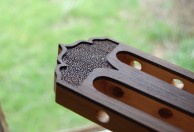Welcome to one of the most active flamenco sites on the Internet. Guests can read most posts but if you want to participate click here to register.
This site is dedicated to the memory of Paco de Lucía, Ron Mitchell, Guy Williams, Linda Elvira, Philip John Lee, Craig Eros, Ben Woods, David Serva and Tom Blackshear who went ahead of us.
We receive 12,200 visitors a month from 200 countries and 1.7 million page impressions a year. To advertise on this site please contact us.
|

|
|
scale length & response
|
You are logged in as Guest
|
|
Users viewing this topic: none
|
|
Login  | |
|

   
estebanana
Posts: 9351
Joined: Oct. 16 2009

|
 RE: scale length & response (in reply to constructordeguitarras) RE: scale length & response (in reply to constructordeguitarras)
|
|
|
quote:
~ 26- 1/8" is a great scale length too with a tenth of an inch of compensation. But everyone is too chicken to even talk about scale in inches......stupid metric system.
That sounds like too much compensation. I make my flamencos 656 mm, unless otherwise ordered by clients, and I use only 1 mm baaalk!--I mean 0.04 inch--compensation. Is it a steel string guitar you're talking about?
_______
Think about how much longer 660 and 664 to 665 ( why no 666?  ) compared to 655 and 650. The 26" 26-1/8" scales compensate very well with a tench of an inch which is basically 2mm. The most perfectly intonated guitars I've made were compensated like that. So I guess thats a 'scant' tenth on the pencil lines. ) compared to 655 and 650. The 26" 26-1/8" scales compensate very well with a tench of an inch which is basically 2mm. The most perfectly intonated guitars I've made were compensated like that. So I guess thats a 'scant' tenth on the pencil lines. 
I marked it out on a stick and 650mm is 15 mm shorter than 665, right. So i compensate the 650 at 1.5 mm and the longer scales at a pencil line tenth of an inch which works out to be mas o menos 2mm fat. I'm just adding about a half mm to a scale 15 mm longer and that tenth works for the 26" scale as well. The 26" scale is my favorite, perhaps I should build with it anyway. I was building that scale when I started, but people got confused because they would only think in terms of the metric system and could not understand why i build in inches. I started called the scales in mm just so I would not have to explain over and over that 26" is an old Spanish scale length.
If you get a chance find this book called Lutes, Viols and Temperament. It goes into the historical scale values other than, and including equal temperament. After I read it I thought differently about compensation. Basically what I got from it, not to go into a long subject that only three people would actually follow, is that a few cents here or there ain't no big thing. Of corse it more than that. It also helped to have Gene Clark just give me that 26" and a tenth recipe for compensating the long scales. But in the end compensation is still not a science and each maker learns to compensate for the way they build.
In the final analysis for myself, I don't even like talking about scale in the metric system, but that is the mensuration system du jour so why fight what you can't change? 26" is so perfect, it's two thirteens.
_____________________________
https://www.stephenfaulkguitars.com
|
|
|
|
REPORT THIS POST AS INAPPROPRIATE |
Date Mar. 12 2013 3:40:11
 |
|

   
Ricardo
Posts: 14806
Joined: Dec. 14 2004
From: Washington DC

|
 RE: scale length & response (in reply to jshelton5040) RE: scale length & response (in reply to jshelton5040)
|
|
|
quote:
As a worthless over general rule of thumb one could say that a short scale results in softer feel but higher action and a long scale results in stiffer feel and lower action assuming the same strings.
I know you are generalizing but it sounds strange to me. By action I mean how high the strings are over the fingerboard (if you mean something else ignore the rest). So, perhaps you mean personally in your case if you use same strings and attempt to have each guitar with the exact same bridge and bone saddle height, THOSE are the results majority of the time??? Weird... do other luthiers concur? I don't understand why that is and of course in the actual world of different builds I don't see such a trend at all. I will say that in all cases, regardless of scale or strings length, and even bridge height, the guitars with LOWEST action are always softest/easiest to play.
quote:
Did you hear that Ricardo? I said Conde's are GREAT - you can print that out and frame it and I'll sign it.
  
quote:
I have found several puzzling things to influence the "ease of playing" including fingerboard thickness, which I could only guess is due to its effect on the flexibility of the neck+fingerboard. I have found that a 5-mm fb seems to make for easier playing than a 6-mm fb, although the thicker fb fits with my overall design better. What fingerboard thicknesses do others prefer?
While fingerboard thickness might make things feel more or less comfy, it doesn't affect actual PLAYABILITY which is like 99.999999% action (ie string height over the fingerboard). Well, you can include bridge height in the there too in terms of "playability" for right hand things, but truth is with the lowest bridge in the world playability is STILL totally an issue of string height over the fingerboard. Jus look at old guitars with necks bent up or sunk soundboard. Low bridge down to zero and the guitar is still stiff.
As far as neck thickness, I say generally wide is ok, thin as possible is ideal within reason. In any case I would not choose a guitar for its neck shape if the action was not acceptable/adjustable.
quote:
I suppose I tend more towards the 660's, but it's very hard to know why.
I would wage money it's only because of action of the particular instruments. Compare string height over 12th fret for all 3 to prove me wrong.
quote:
_____________________________
CD's and transcriptions available here:
www.ricardomarlow.com
|
|
|
|
REPORT THIS POST AS INAPPROPRIATE |
Date Mar. 12 2013 17:35:06
 |
|
 New Messages New Messages |
 No New Messages No New Messages |
 Hot Topic w/ New Messages Hot Topic w/ New Messages |
 Hot Topic w/o New Messages Hot Topic w/o New Messages |
 Locked w/ New Messages Locked w/ New Messages |
 Locked w/o New Messages Locked w/o New Messages |
|
 Post New Thread
Post New Thread
 Reply to Message
Reply to Message
 Post New Poll
Post New Poll
 Submit Vote
Submit Vote
 Delete My Own Post
Delete My Own Post
 Delete My Own Thread
Delete My Own Thread
 Rate Posts
Rate Posts
|
|
|
Forum Software powered by ASP Playground Advanced Edition 2.0.5
Copyright © 2000 - 2003 ASPPlayground.NET |
0.078125 secs.
|


 Printable Version
Printable Version










 ) compared to 655 and 650. The 26" 26-1/8" scales compensate very well with a tench of an inch which is basically 2mm. The most perfectly intonated guitars I've made were compensated like that. So I guess thats a 'scant' tenth on the pencil lines.
) compared to 655 and 650. The 26" 26-1/8" scales compensate very well with a tench of an inch which is basically 2mm. The most perfectly intonated guitars I've made were compensated like that. So I guess thats a 'scant' tenth on the pencil lines. 






 New Messages
New Messages No New Messages
No New Messages Hot Topic w/ New Messages
Hot Topic w/ New Messages Hot Topic w/o New Messages
Hot Topic w/o New Messages Locked w/ New Messages
Locked w/ New Messages Locked w/o New Messages
Locked w/o New Messages Post New Thread
Post New Thread